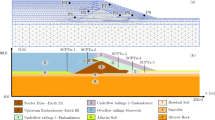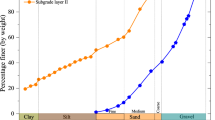Abstract
Column supported embankments (CSEs) are used to overcome common problems associated with the construction of embankments over soft compressible soils. The use of granular columns as deep foundation elements for CSEs can be problematic in soft soils due to the lack of adequate lateral confining pressure, particularly in the upper portion of the column. Using a high-strength geosynthetic for granular column confinement forms geosynthetic encased columns (GECs); the confinement imposed by the geosynthetic increases the strength of the column, and also prevents its lateral displacement into the soft surrounding soil. This paper presents the results of finite element analyses of a hypothetical geosynthetic reinforced column supported embankment (GRCSE) (i.e., a CSE underlain by geosynthetic reinforcement) that is constructed with GECs as the deep foundation elements. Full three-dimensional (3-d), 3-d unit cell, and axisymmetric unit cell analyses of the GRCSE were carried out to investigate the validity of the unit cell concept. The effect of the degree of nodal constraint along the bottom boundary when numerically modeling GRCSEs was also studied in this paper. Numerical results show that a full 3-d idealization is required to more precisely determine the tension forces that are produced in the geosynthetic reinforcement that underlies the GRCSE. A number of design parameters such as the average vertical stresses carried by the GECs, lateral displacement of the GECs, and the maximum settlement of the soft foundation soil, however, can be successfully calculated using unit cell analyses.


















Similar content being viewed by others
Abbreviations
- c :
-
Effective cohesion (Pa)
- D :
-
Column diameter (m)
- D e :
-
Center-to-center column spacing (m)
- e :
-
Void ratio at unit pressure (dimensionless)
- E :
-
Effective Young’s modulus (Pa)
- J :
-
Tensile modulus (N/m)
- M :
-
Slope of the critical state line (dimensionless)
- ϕ :
-
Friction angle (degree)
- κ :
-
The slope of the swelling line (dimensionless)
- λ :
-
The slope of the virgin consolidation line (dimensionless)
- ν :
-
Poisson’s ratio (dimensionless)
- Ψ :
-
Dilatancy angle (degree)
References
Alexiew D, Brokemper D, Lothspeich S (2005) Geotextile encased columns (GEC): load capacity, geotextile selection and pre-design graphs. In: Proceedings of the geo-frontiers 2005 congress, Austin, Texas, pp 1–14
Al-Joulani N, Bauer GE (1995) Laboratory behavior of sleeve-reinforced stone columns. Geosynthetics ‘95 conference proceedings, pp 1111–1123
Almeida MSS, Hosseinpour I, Riccio M (2013) Performance of a geosynthetic-encased column (GEC) in soft ground: numerical and analytical studies. Geosynth Int 20(4):252–262
Balasubramanian AS, Chaudhry AR (1978) Deformation and strength characteristics of soft Bangkok clay. J Geotech Eng Div ASCE 104(9):1153–1167
Borges JL, Domingues TS, Cardoso AS (2009) Embankments on soft soil reinforced with stone columns: numerical analysis and proposal of a new design method. Geotech Geol Eng 27(6):667–679
Brooker EW, Ireland HO (1965) Earth pressures at rest related to stress history. Can Geotech J 2(1):1–15
BS 8006 (1995) Code of practice for strengthened/reinforced soils and other fills. BSI, Milton Keynes
Carlson BO (1987) Armerad Jord beräkningsprinciper för banker på pålar. Terranova, Distr. SGI., Linköping (in Swedish)
Castro J, Sagaseta C (2009) Consolidation around stone columns. Influence of column deformation. Int J Numer Anal Meth Geomech 33(7):851–877
Chen RP, Chen YM, Han J, Xu ZZ (2008) A theoretical solution for pile-supported embankments on soft soils under one-dimensional compression. Can Geotech J 45(5):611–623
Chew SH, Phoon HL, Hello BL, Villard P (2006) Geosynthetic reinforced piled embankment: large-scale model tests and numerical modeling. In: 8th International conference on geosynthetics, Geosynthetics, Yokohama, Japan, September 18–22, vol 1–4, pp 901–904
Collin JG (2004) Column supported embankment design considerations. In: Labuz JF, Bentler JG (eds) Proceedings of the 52nd annual geotechnical engineering conference, University of Minnesota, St. Paul, pp 51–78
Elias V, Welsh J, Warren J, Lukas R, Collin G, Berg RR (2006) Ground improvement methods, volume II, FHWA-NHI-06-020
Elsawy MBD (2013) Behaviour of soft ground improved by conventional and geogrid-encased stone columns, based on FEM study. Geosynth Int 20(4):276–285
Han J, Gabr MA (2002) Numerical analysis of geosynthetic-reinforced and pile-supported earth platforms over soft soil. J Geotech Geoenviron Eng 128(1):44–53
Han J, Wayne MH (2000) Pile-soil-geosynthetic interactions in geosynthetic reinforced platform/piled embankments over soft soil. In: Presentation at 79th annual transportation research board meeting, Washington, DC
Han J, Collin JG, Huang J (2004) Recent development of geosynthetic-reinforced column-supported embankments. In: Proceedings of the 55th highway geology symposium, Kansas City, Missouri, September 7–10, pp 299–321
Han J, Huang J, Porbaha A (2005) 2D numerical modeling of a constructed geosynthetic-reinforced embankment over deep mixed columns. ASCE Geotechnical Special Publication (GSP) No. 131: contemporary issues in foundation engineering, ASCE GeoFrontiers, Austin, TX, pp 24–26
Han J, Oztoprak S, Parsons RL, Huang J (2007) Numerical analysis of foundation columns to support widening of embankments. Comput Geotech 34(6):435–448
Hibbitt, Karlsson and Sorensen Inc. (2007) ABAQUS user’s manual, version 6.7, Pawtucket, RI
Huang J, Han J, Collin JG (2006) Deformations of geosynthetic-reinforced column-supported embankments. In: Proceedings of the 8th international geosynthetics conference, 18–22 September, Yokohama, Japan, pp 1029–1032
Huang J, Han J, Oztoprak S (2009) Coupled mechanical and hydraulic modeling of geosynthetic-reinforced column-supported embankments. J Geotech Geoenviron Eng 135(8):1011–1021
Jenck O, Dias D, Kastner R (2009) Three-dimensional numerical modeling of a piled embankment. Int J Geomech 9(3):102–112
Jones CJPF, Lawson CR, Ayres DJ (1990) Geotextiles reinforced piled embankments. In: 4th international conference on geotextiles, geomembranes and related products, Den Haag, vol 1, pp 155–160
Kaliakin VN, Khabbazian M, Meehan CL (2012) Modeling the behavior of geosynthetic encased columns: influence of granular soil constitutive model. Int J Geomech ASCE 12(4):357–369. doi:10.1061/(ASCE)GM.1943-5622.0000084
Kempfert H-G, Gobel C, Alexiew D, Heitz C (2004) German recommendations for reinforced embankments on pile-similar elements. EuroGeo3: 3rd European geosynthetics conference, geotechnical engineering with geosynthetics, Munich, pp 279–284
Kempton G, Russell D, Pierpoint ND, Jones CJFP (1998) Two- and three-dimensional numerical analysis of the performance of piled embankments. In: Proceedings of the 6th international conference on geosynthetics, Atlanta, GA, pp 767–772
Khabbazian M (2011) Numerical simulation of geosynthetic encased columns used individually and in group configurations. A dissertation submitted to the Faculty of the University of Delaware in partial fulfillment of the requirements for the degree of Doctor of Philosophy in Civil Engineering
Khabbazian M, Kaliakin VN, Meehan CL (2009) 3D analyses of geosynthetic encased stone columns. In: Proceedings of international foundations congress and equipment expo 09 (IFCEE09), contemporary topics in ground modification, problem soils, and geo-support, geotechnical special publication No. 187, Orlando, FL, March 15–19, ASCE, pp 201–208
Khabbazian M, Kaliakin VN, Meehan CL (2010a) Numerical study of the effect of geosynthetic encasement on the behaviour of granular columns. Geosynth Int Thomas Telford 17(3):132–143
Khabbazian M, Meehan CL, Kaliakin VN (2010b) Numerical study of effect of encasement on stone column performance. In: Proceedings GeoFlorida 2010: advances in analysis, modeling & design, geotechnical special publication No. 199, West Palm Beach, FL, February 20–24, 2010, ASCE, Reston, VA, pp 184–193
Khabbazian M, Kaliakin VN, Meehan CL (2011a) Performance of quasilinear elastic constitutive models in simulation of geosynthetic encased columns. Comput Geotech 38(8):998–1007
Khabbazian M, Meehan CL, Kaliakin VN (2011b) Influence of granular soil constitutive model when simulating the behavior of geosynthetic encased columns. Geo-Frontiers 2011: advances in geotechnical engineering, geotechnical special publication No. 211, Dallas, TX, March 13–16, 2011, ASCE, Reston, VA, pp 539–548
Khabbazian M, Kaliakin VN, Meehan CL (2012) Numerical simulation of column supported embankments with geosynthetic encased columns: influence of soft soil constitutive model. Geo-Congress 2012: state of the art and practice in geotechnical engineering, geotechnical special publication no. 225, Oakland, CA, March 25–29, 2012, ASCE, Reston, VA, 1–10. doi:10.1061/9780784412121.001
Lawson CR (1992) Soil reinforcement with geosynthetics. Southeast Asian Geotechnical Society (SEAGS), Appl Ground Improv Tech, pp 55–74
Lee KL, Seed HB (1967) Drained strength characteristics of sands. J Soil Mech Found Div ASCE 93(6):117–141
Liu HL, Ng CWW, Fei K (2007) Performance of a geogrid-reinforced and pile supported highway embankment over soft clay: case study. J Geotech Geoenviron Eng 133(12):1483–1493
Lo SR, Zhang R, Mak J (2010) Geosynthetic-encased stone columns in soft clay: a numerical study. Geotext Geomembr 28(3):292–302
Malarvizhi SN, Ilamparuthi K (2007) Performance of stone column encased with geogrids. In: Proceedings of the 4th international conference on soft soil engineering, pp 309–314
McKelvey JA, III (1994) Consideration of equipment loadings in geosynthetic lined slope designs. In: Proceedings of the 8th international conference on computer methods and advances in geomechanics, Rotterdam, vol 2, pp 1371–1377
Murugesan S, Rajagopal K (2006) Geosynthetic-encased stone columns: numerical evaluation. Geotext Geomembr 24(6):349–358
Murugesan S, Rajagopal K (2007) Model tests on geosynthetic-encased stone columns. Geosynth Int 14(6):346–354
Oh YI, Shin EC (2007) Reinforcement and arching effect of geogrid-reinforced and pile-supported embankment on marine soft ground. Mar Georesour Geotechnol 25(2):97–118
Park S, Yoo C, Lee D (2007). A study on the geogrid reinforced stone column system for settlement reduction effect. In: Proceedings of the seventeenth international offshore and polar engineering conference, Lisbon, Portugal, July 1–6, pp 1636–1641
Plaut RH, Filz GM (2010) Analysis of geosynthetic reinforcement in pile-supported embankments. Part III: axisymmetric model. Geosynth Int 17(2):77–85
Pulko B, Majes B, Logar J (2011) Geosynthetic-encased stone columns: analytical calculation model. Geotext Geomembr 29(1):29–39
Russell D, Pierpoint N (1997) An assessment of design methods for piled embankments. Ground Eng 30(11):39–44
Smith M, Filz G (2007) Axisymmetric numerical modeling of a unit cell in geosynthetic-reinforced, column-supported embankments. Geosynth Int 14(1):13–22
Stewart ME, Filz GM (2005) Loads on geosynthetic reinforcement in bridging layers for pile-supported embankments. In: Proceedings of geo-frontiers 2005, ASCE, Austin
Tan SA, Tjahyono S, Oo KK (2008) Simplified plane-strain modeling of stone-column reinforced ground. J Geotech Geoenviron Eng 134(2):185–194
Vega-Meyer R, Shao Y (2005) Geogrid-reinforced and pile-supported roadway embankment. Geo-Frontiers 2005, contemporary issues in foundation engineering, geotechnical special publication no. 131, January 24–26, Austin, Texas
Wachman GS, Biolzi L, Labuz JF (2010) Structural behavior of a pile-supported embankment. J Geotech Geoenviron Eng 136(1):26–34
Yan L, Yang JS, Han J (2006) Parametric study of geosynthetic-reinforced pile-supported embankments. Advances in earth structures: research to practice, ASCE Geotechnical Special Publication No. 151. In: Yin J-H, White DJ, Han J, Lin G (eds) Proceedings of the GeoShanghai international conference 2006, Shanghai, China, June 6–8, pp 255–261
Yoo C (2010) Performance of geosynthetic-encased stone columns in embankment construction: numerical investigation. J Geotech Geoenviron Eng 138(8):1148–1160
Yoo C, Kim SB (2009) Numerical modeling of geosynthetic-encased stone column-reinforced ground. Geosynth Int 16(3):116–126
Zheng JJ, Chen BG, Lu YE, Abusharar SW, Yin JH (2009) The performance of an embankment on soft ground reinforced with geosynthetics and pile walls. Geosynth Int 16(3):173–182
Acknowledgments
This material is based upon work supported in part by the Geosynthetic Institute under its GSI Fellowship Program.
Author information
Authors and Affiliations
Corresponding author
Additional information
Majid Khabbazian was formerly a graduate student in the Department of Civil and Environmental Engineering at the University of Delaware.
Rights and permissions
About this article
Cite this article
Khabbazian, M., Kaliakin, V.N. & Meehan, C.L. Column Supported Embankments with Geosynthetic Encased Columns: Validity of the Unit Cell Concept. Geotech Geol Eng 33, 425–442 (2015). https://doi.org/10.1007/s10706-014-9826-8
Received:
Accepted:
Published:
Issue Date:
DOI: https://doi.org/10.1007/s10706-014-9826-8




